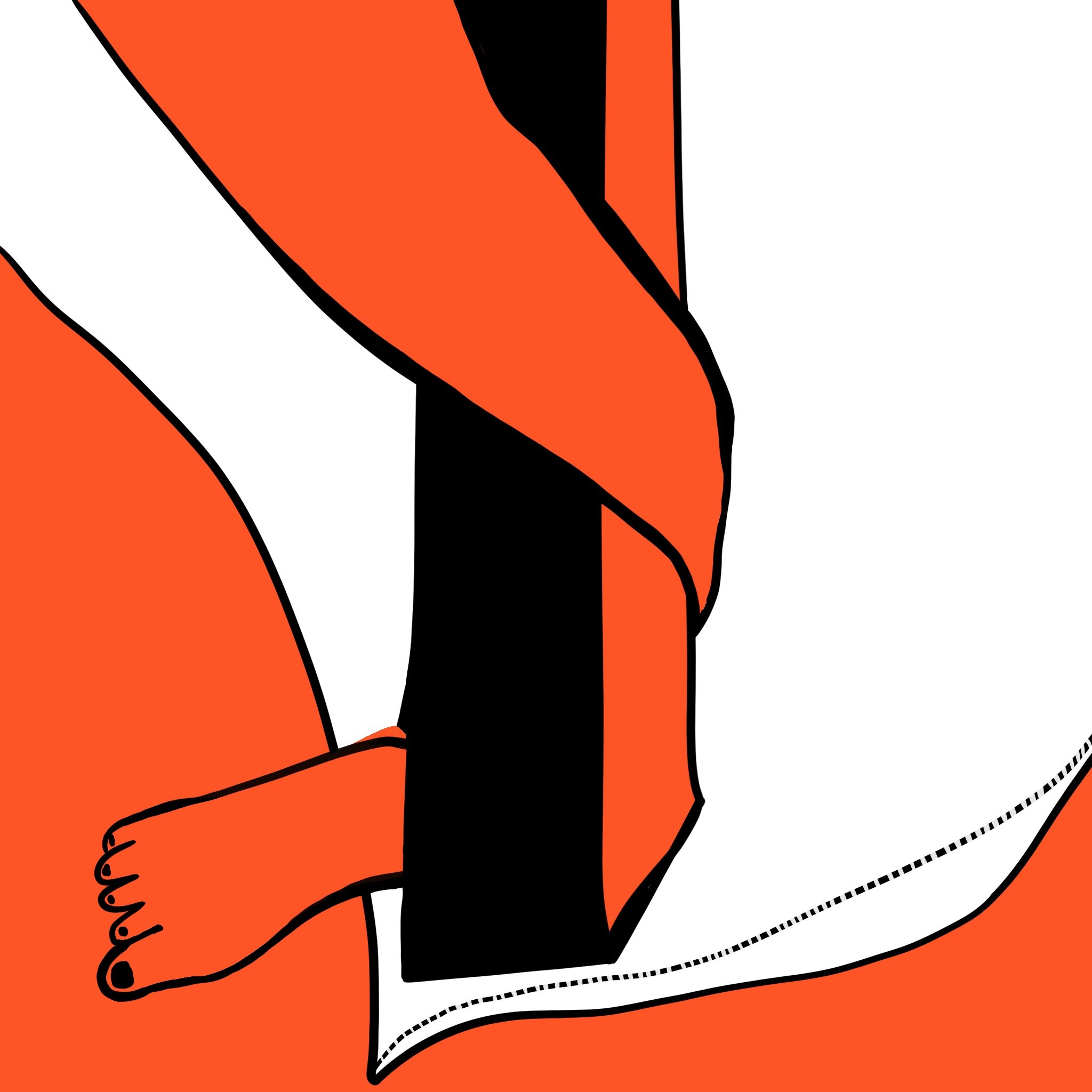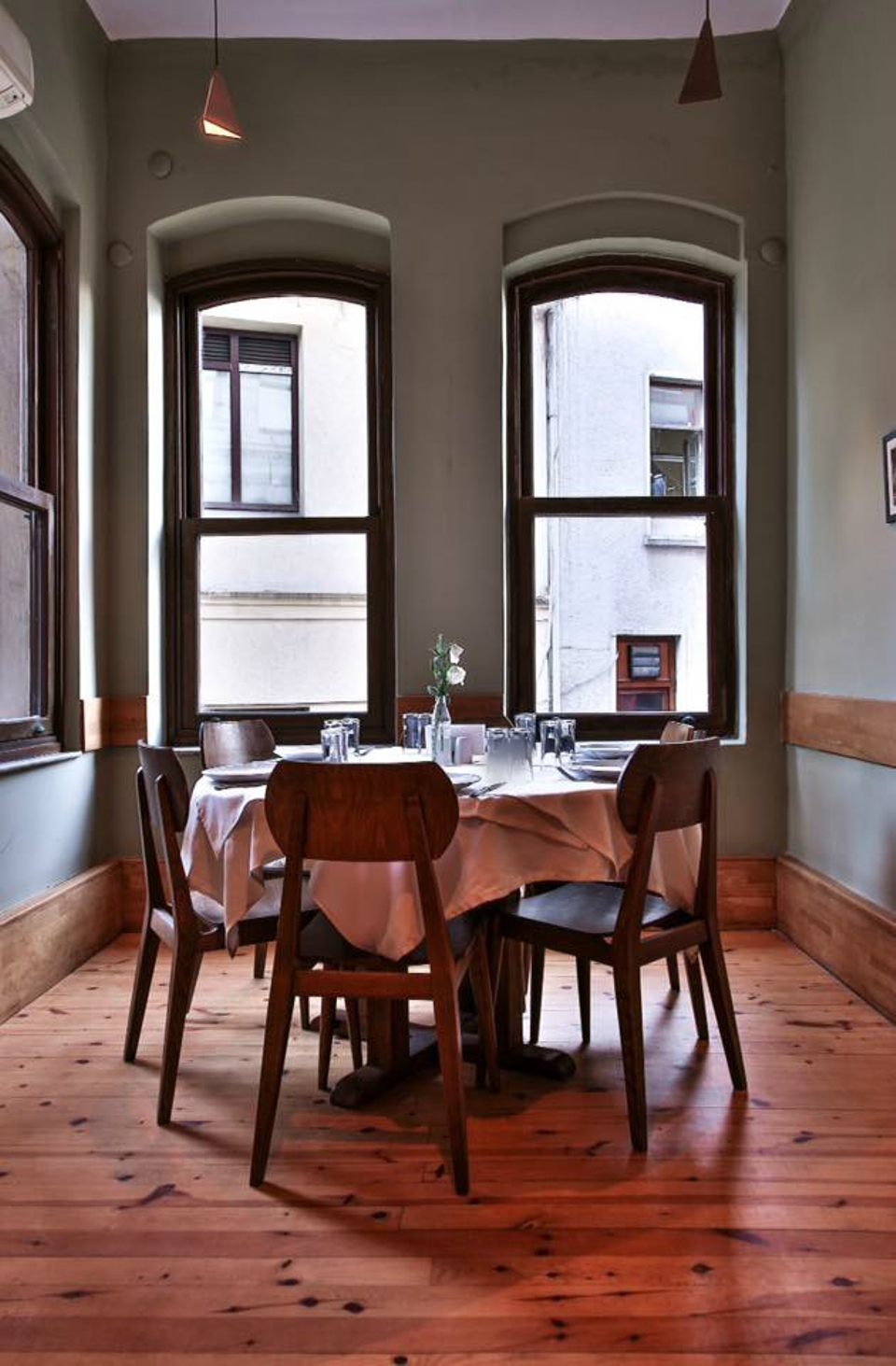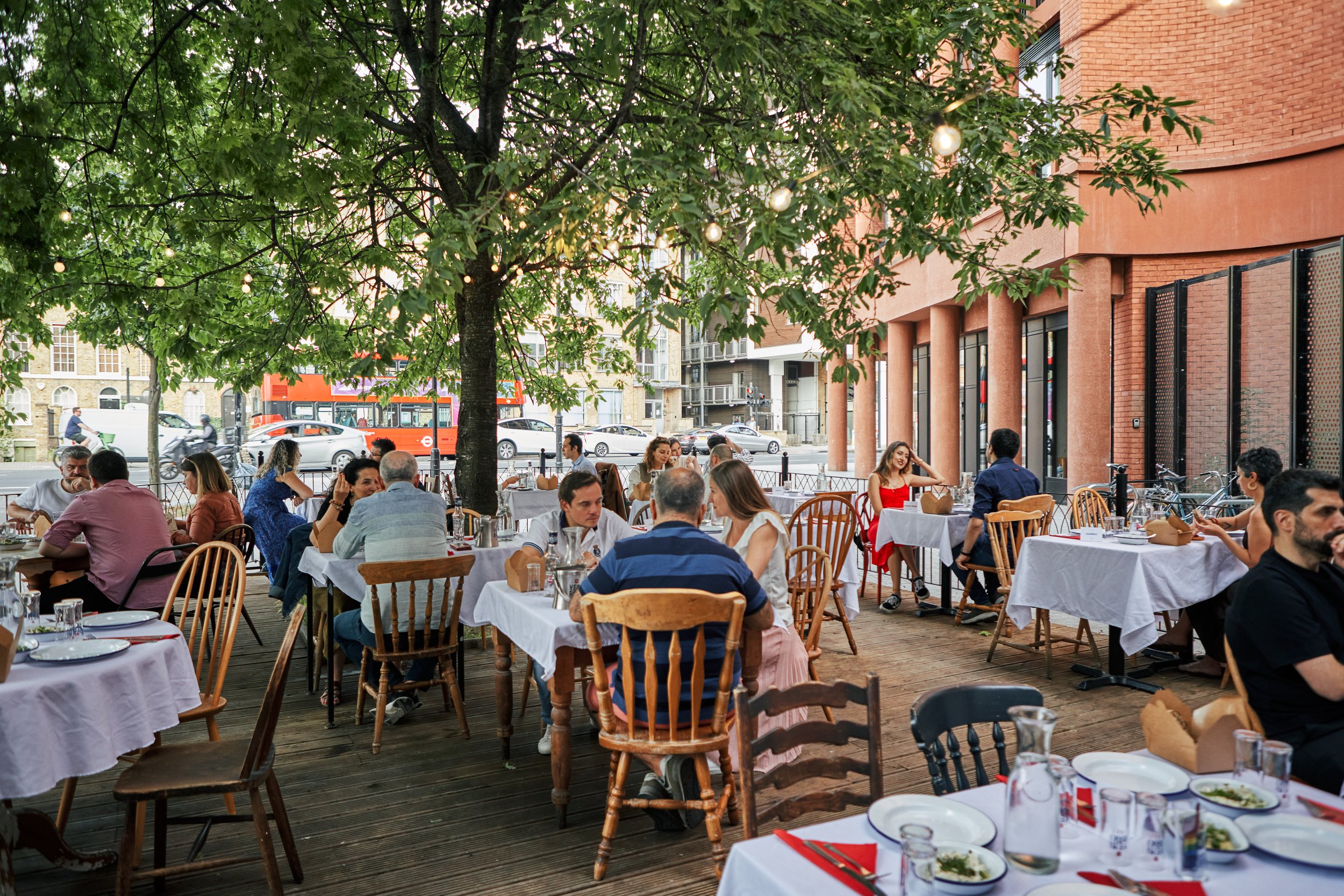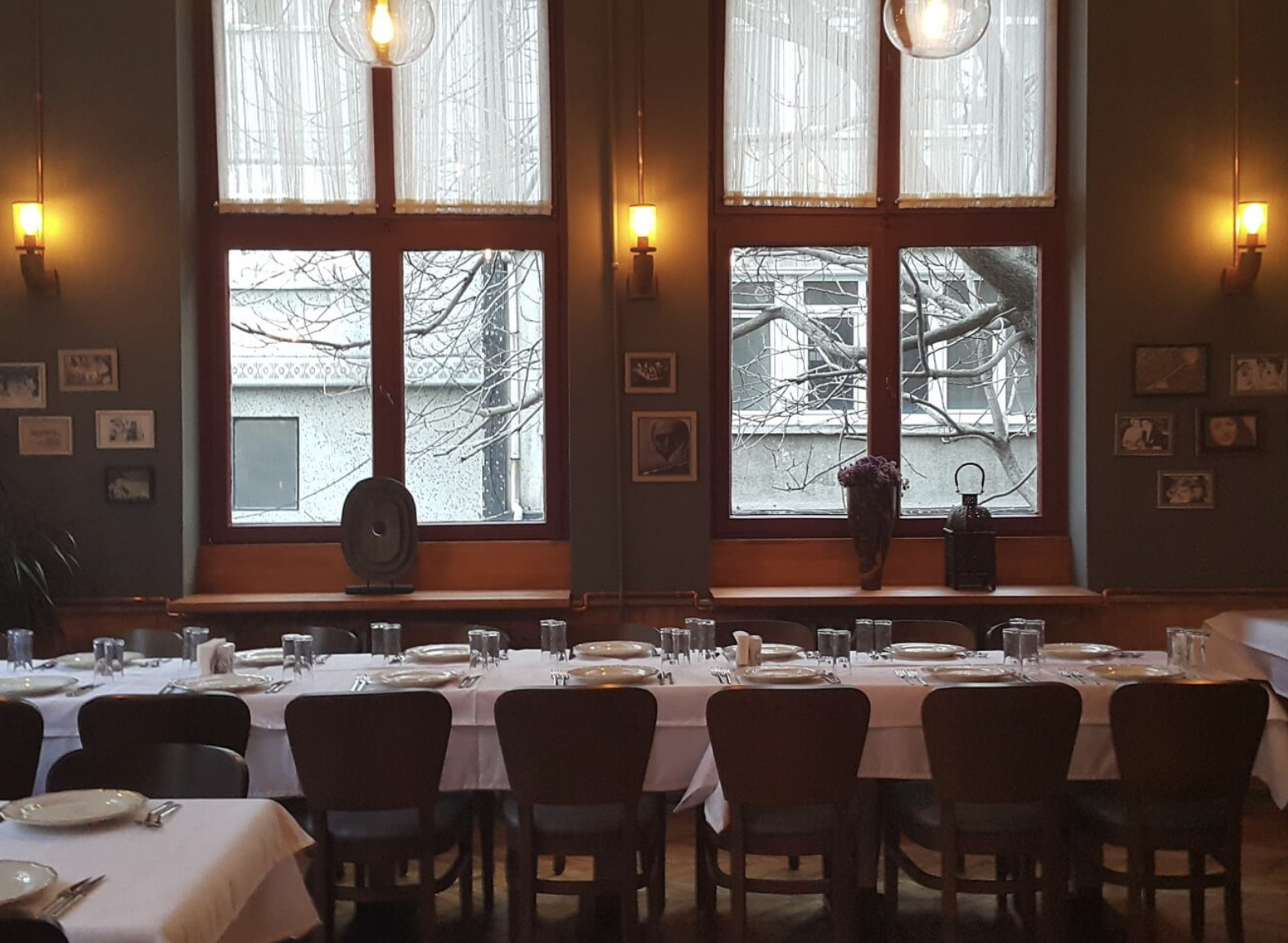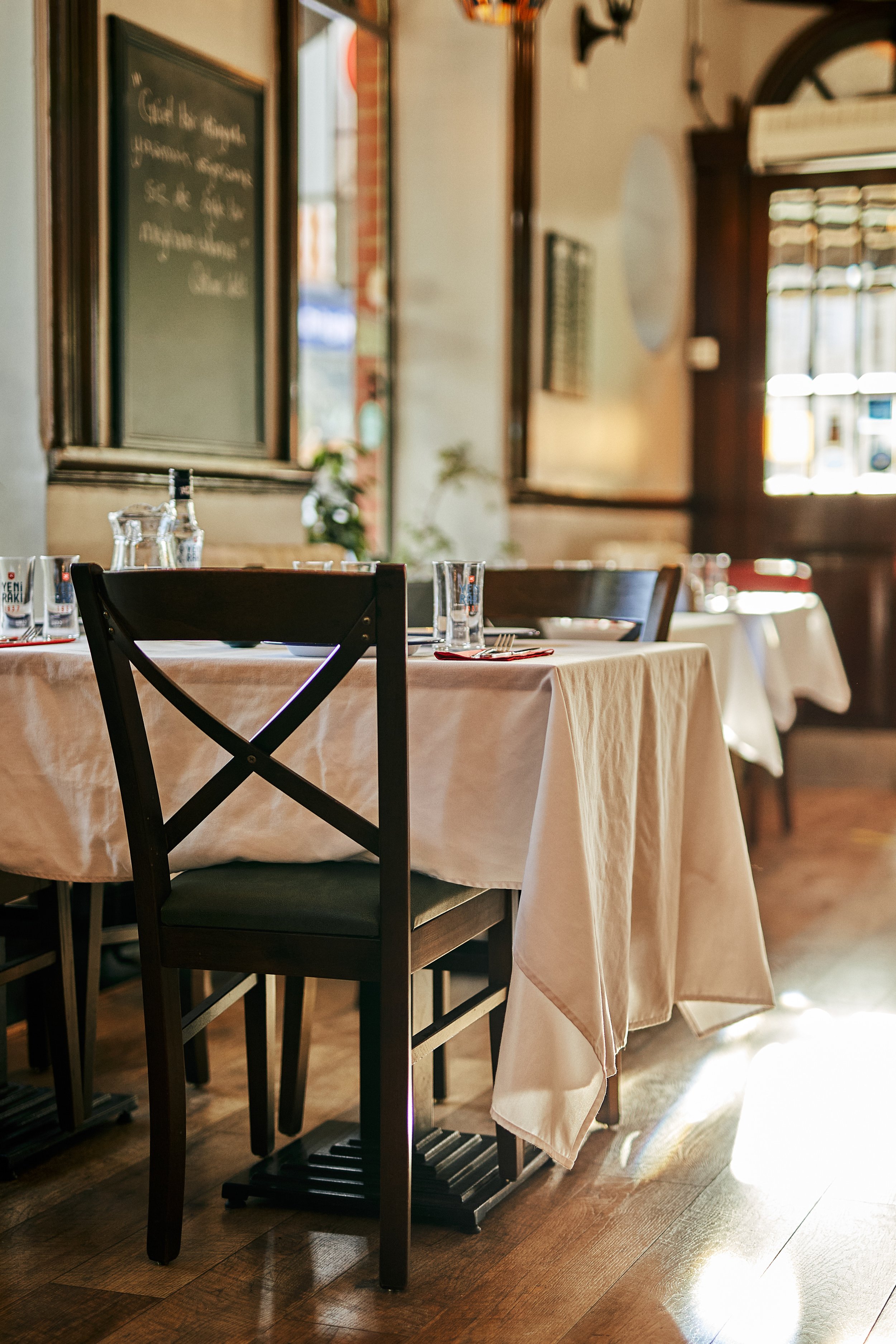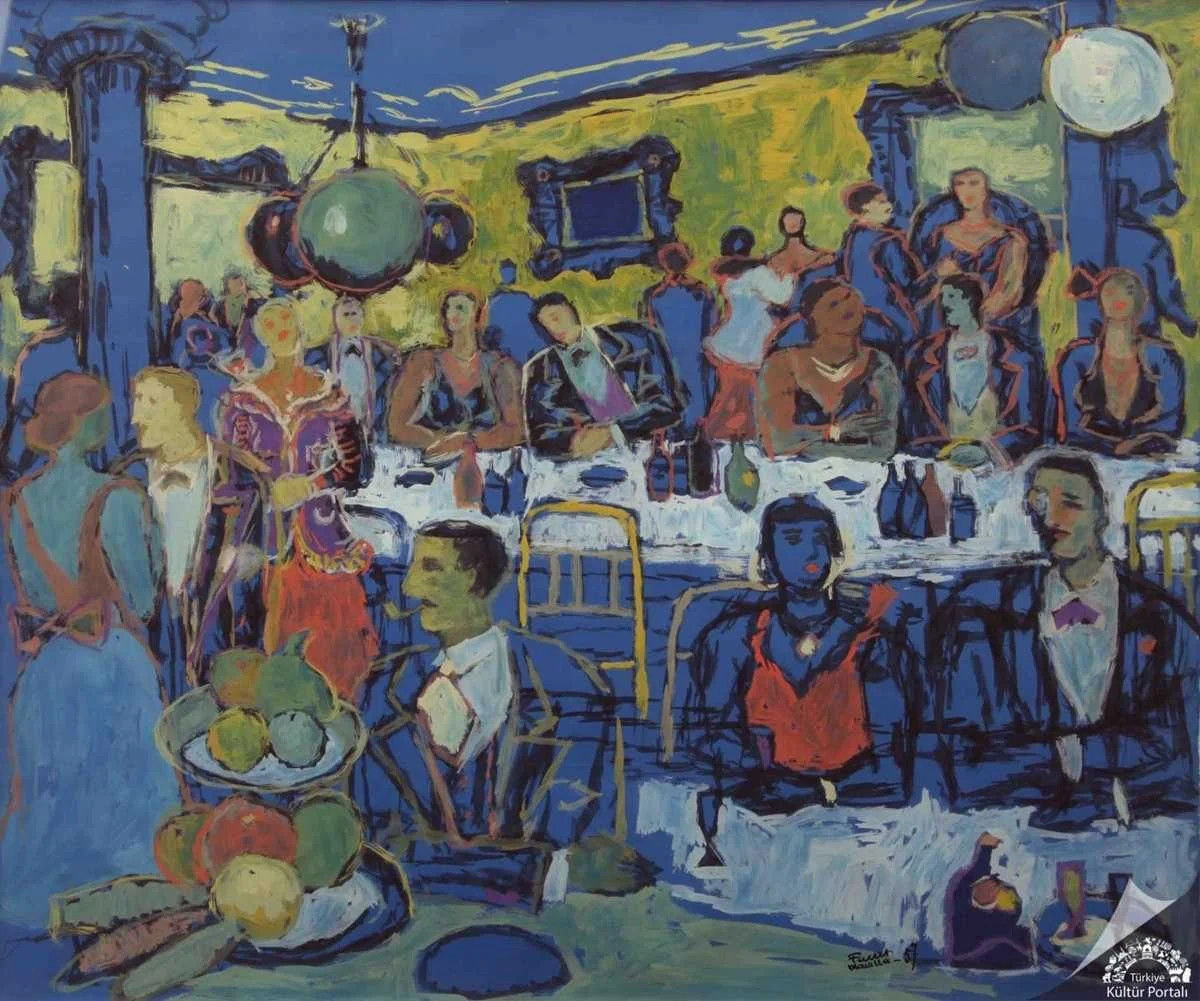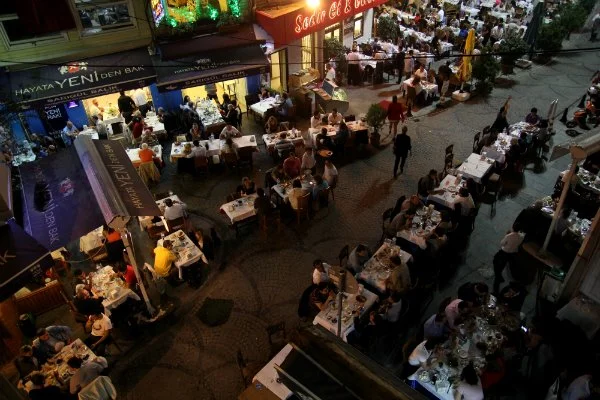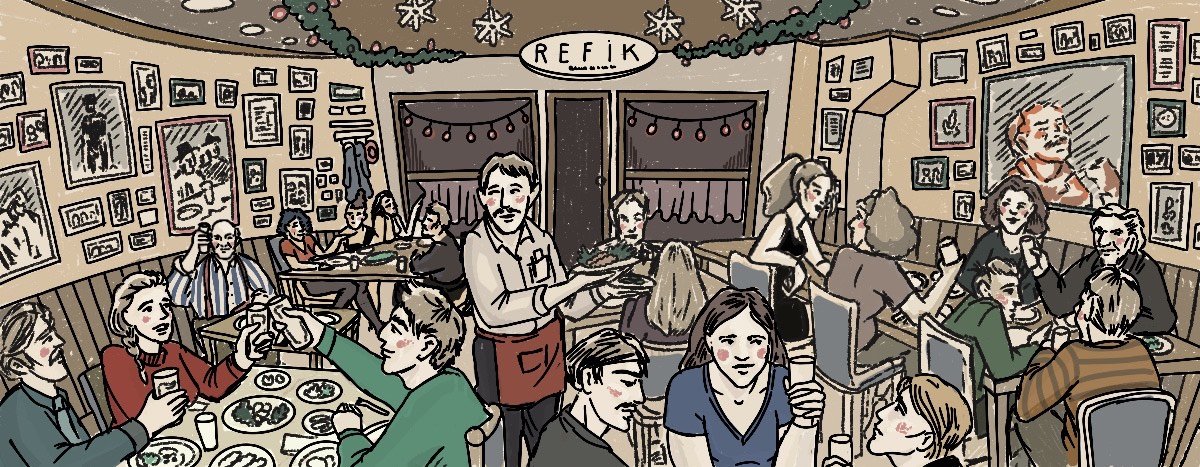Crafting the Seat, Crafting the Experience
In the bustling ambiance of a meyhane, every element plays a crucial role in shaping the overall experience. Among these, the humble chair emerges as a silent yet pivotal character, influencing not only physical comfort but also psychological perceptions and social interactions.
Pop-up Meyhane in Enfield photo by Ferhat Elik
The meyhane chair embodies a unique sense of versatility and social connectivity, contributing to the dynamic atmosphere of these traditional establishments. Its inherent mobility facilitates fluid interactions and seamless transitions, allowing people to effortlessly move between tables and conversations. This adaptability not only fosters social exchange but also enables the organic rearrangement of the meyhane's spatial layout, ensuring that it remains responsive to the evolving dynamics of the crowd. Whether it’s packed or quiet, the chairs help maintain order by replacement. The spacing of chairs is also thoughtfully considered to enhance comfort and accessibility, ensuring that regulars feel welcomed and at ease in their surroundings.
Safa Meyhanesi
At the heart of the meyhane chair's design is its role in nurturing gathering and connection.
Unlike conventional dining settings where chairs are often arranged for formal meals, meyhane chairs are usually lighter, to promote communal interactions. One can borrow a seat from another table, and bring two together to make a makeshift bed for a tired child.
Whether regulars choose to lean back-to-back with neighbouring tables, sit side-by-side, or pull chairs closer to engage in intimate conversations, the spatial organization of meyhane chairs reflects their function as catalysts for shared experiences and meaningful connections. Single chairs dominate the space, offering flexibility and spontaneity in seating configurations. Tables are clustered together, fostering a sense of closeness and companionship among diners. Rarely do we find pairs seated alone; instead, the layout encourages group gatherings and communal dining experiences.
This deliberate design choice promotes a sense of belonging and inclusivity, inviting regulars to participate in the collective spirit of the meyhane. Beyond their utilitarian function, the materials and design of meyhane chairs communicate subtle psychological cues that influence regulars' perceptions and behaviours. Whether crafted from wood, metal, or rattan, each material conveys a distinct aesthetic and tactile experience, contributing to the overall ambience of the space.
Before meyhane chairs, there were other ones…
Before understanding and thinking about meyhane chairs and their process, we must look at the core of the chairs. What do they symbolize? How subtly do they represent purpose, more than most other pieces of furniture?
The chair, with its single-person structure and hundreds of different options, is one of the oldest types of items in human history. It began to gain its real prevalence in the 16th century. With its various areas of use, it became a respected design object. They can be made from different materials such as plastic, wood, or iron. Models of different sizes can be developed for adults and children. In short, the chair was always shaped according to the space and need where they are located.
Illustrated by Duru Bebekoğlu
Owning a chair symbolizes representation, *actually* having a seat at the table, to being able to engage in social interactions, conversations and memories. In the centuries following the empires, wars and world history where the chairs were used in a more symbolic way (such as showing an emperor’s genius or seats around a table where important decisions were made), chairs entered daily life. These products became items that everyone could afford and use. Therefore, chairs also underwent changes that reflected the spirit of the times. As the number of materials used in their manufacture increased, significant changes were made in their design as well. Countless examples were introduced to the market. Advances in technology also led to the emergence of chairs that could be upholstered with leather, in addition to wooden laminate chairs. Apart from the chair being an agent of representation, it was also used for reflecting different style eras through the centuries.
Brooklyn Museum, Unknown. Side Chair, ca. 1760. Mahogany with upholstery, 40 x 23 1/2 x 22 1/4 in. (101.6 x 59.7 x 56.5 cm). Brooklyn Museum, Anonymous gift, 42.118.3. Creative Commons-BY (Photo: Brooklyn Museum
Chair, ca. 1400-1292 B.C.E. Wood, bone, modern fiber, 35 7/16 x 17 15/16 x 18 5/8 in. (90 x 45.6 x 47.3 cm). Brooklyn Museum, Charles Edwin Wilbour Fund, 37.40E. Creative Commons-BY (Photo: Brooklyn Museum
In the 1880s, amidst John Ruskin's idealism, the "Arts and Crafts" movement began to evoke simple medieval models. Advocating that aesthetics should never be separated from design, William Morris emphasized that chairs should be designed alongside aesthetics. The "Art Nouveau" movement introduced us to chairs with curved forms and botanical curves.
Henry van de Velde (1863-1957, Belgian), source: www.kirklandmuseum.org
Then, Gaudi's surrealistic approaches would touch upon the progression of chairs in the timeline. Architect Charles Rennie Mackintosh intersected chairs with more geometric forms from Scotland.
Charles Rennie Mackintosh chair design, source: www.dezeen.com
Architect Frank Lloyd Wright opened a new era in chairs with "industrial production chairs". During this period, the design process for chairs accelerated, and many architects of the period made significant contributions.
Birth of the Thonet Chair, a Meyhane classic
At the end of the 19th century, the combination of technology and industry allowed for the development of new forms using heated bent wood. These forms, which have infinite value, remain popular today. Michael Thonet was a valuable designer who left his mark on this era. Thonet chair is perhaps one of the most iconic chairs we use in homes, with its material, usability, and potential for different designs, is one of those that make us feel closest to the meyhane. The “214” named coffee shop chair (Thonet Chair) is known as one of the most successful piece in modern furniture history, remaining in production until today. These chairs quickly got into the lives of many historical philosophers, writers and musicians. Leo Tolstoy used Thonet’s designs in his whole house. The entire orchestra of Johann Strauss sat on these chairs; Charlie Chaplin used this design in his movies. Starting from the 19th century, Thonet chair has gained its place in dining spots, bars, pubs, restaurants, and also meyhanes as these places became more integrated with the public use. Stools changed to Thonet chairs and birthed the pubs, restaurants and meyhanes that we know today.
Thonet Chair, www.thonet.de
Examples of bentwood chairs in different meyhanes
1. Şahika Küçük Meyhane 2. Pop-up Meyhane by Istanbul Elsewhere 3. Güneşin Sofrası
The Dynamics of Meyhane Chairs Through Time
While the “act of sitting” was here for centuries, as well as chairs; meyhane chairs that we know of only found their place around the table during the late 19th century. This was mostly due to different establishments of meyhanes and the social structure of the time. With chairs that we know of coming into the picture, the act of gathering and sharing only increased and created the atmosphere of meyhanes that we know today.
During the Ottoman period, various types of meyhanes emerged. Gedikli meyhanes were those registered with the state, while koltuk meyhaneleri were unregistered establishments often tucked away in corners of shops without permission to sell alcohol, such as grocers and greengrocers.
Ayaklı Meyhane, image source: Aposto
Another type of meyhane of that period was the "ayaklı meyhaneler," which was run by itinerant rakı sellers. The sellers wrapped a leather pouch with a spigot around their waists and concealed their glasses inside the cloak they wore. The poor of the time were their customers. Recognized by the towel draped over their shoulders, the meyhane keeper and the customer would withdraw to a corner to conduct their business. If customers were lucky, they would have a piece of fruit with them as a meze or receive a complimentary serving of roasted chickpeas from the seller.
A mix of koltuk meyhaneleri and ayaklı meyhaneler, became somewhere in between. In these places, drinks were served in glasses and people usually drank while standing. Shopkeepers who went to open their shops early in the morning would come to these inexpensive places to start their day, while workers returning home as the day drew to a close would come to these places to unwind.
Therefore, the concepts of chairs and seating were quite layered and sometimes absent in meyhanes in the past. Gedikli meyhanes also did not have tables and chairs; food and drinks would come in a tray, and people would sit on straw stools. Although it would be appropriate to consider this as a form of seating and chair, even before the concept of a chair was understood, seating arrangements in meyhanes were only occasionally established.
Karagöz, end of 19th Century, sitting in a meyhane with table and chairs by Ali Sami, Karagöz Beyoğlu'nda.
New Seating Arrangements
The Tanzimat-era and modernization movements left a mark on meyhanes and their seating arrangements. By the 1880s, tables and chairs started dominating the space in these venues. Changes in the political landscape of the Ottoman Empire also influenced the forms of meyhanes. During this time, unlicensed koltuk meyhaneleri secured licenses and opened affordable establishments. Those continuing from the gedikli meyhanes evolved into licensed liquor restaurants. Despite sharing similar seating arrangements with chairs and tables, meyhanes and other drinking spots tailored to different classes and groups, still exhibited distinct forms.
A painting of a drinking establishment by Fikret Mualla. Source: Ankara Painting and Sculpture Museum / Editor Zeynep Yasa-Yaman, Photographs: Sıtkı Fırat, Ankara: Ministry of Culture and Tourism, 2012. , Aposto
As we approach the present day, with materials in interior decoration, chairs have received their well-deserved representation in terms of form and aesthetic use. The Thonet chair gained its place around the table, offering the wooden, known feeling of meyhanes.
In the 1930s, one of the night tables in Balıkpazarı, Beyoğlu... Beyoğlu 1930 - With the Photographs of Selâhattin Giz, Beyoğlu in the 1930s, Galeri Alfa Publications, 1997.
Today, the distinction between public and private spaces blurs as meyhanes extend their seating outdoors to more visible areas, alongside their interior arrangements. In places like Çiçek Pasajı, Nevizade and various streets in Istanbul renowned for their meyhanes, establishments share the sidewalks with neighbouring venues, setting up chairs and tables outside. Sitting on similar chairs outdoors creates a distinctive experience, fostering a collective memory as regulars share the street ambience and sounds with neighbouring meyhanes.
Samatya meyhanes, source: meyhanedeyiz.biz
Designing our seating arrangement
When considering how to decorate our meyhane, the existing seating arrangements offer valuable insights to guide our ideas. Calculating the distance between chairs at each table is crucial as it directly influences circulation. Maintaining a balance between circulation and seating is essential, as it shapes the perception of the space; it shouldn't feel overly empty or excessively crowded.
As previously mentioned, while chairs are typically singular, meyhanes are inherently communal spaces. Visitors often prefer to sit in groups, seek more secluded areas, or enjoy a view from the window. Depending on these preferences, a meyhane can offer various seating arrangements, such as long couches and strategically placed chairs. Flexibility is key to accommodating the dynamic nature of the meyhane environment, ensuring that seating arrangements can be easily adjusted.
Refik, drawing by Glennis, source: meyhanedeyiz.biz
Furthermore, lightweight furniture is advantageous for both flexibility and ease of floor cleaning, as meyhane chairs are frequently used and replaced approximately every five years. Chairs with arms should be assessed to ensure they can fit under tables, and attention to detail is paramount to prevent any discomfort to customers or staff.
Güneşin Sofrası
In recent years, due to restrictions on smoking in enclosed spaces, it has become necessary for meyhanes and other establishments to provide designated smoking areas outside. Alongside this, some individuals accompany their smoking friends, necessitating seating options conducive to short-term stays, such as benches or stools, in addition to the interior seating areas where people spend longer periods. Incorporating such seating elements into the design not only accommodates smokers but also adds versatility to the space, catering to the diverse needs of regulars.
As we navigate the intricate interplay between mobility, interaction, and design, it becomes evident that meyhane chairs are not merely objects but gateways to the richness of human experience. From their strategic placement to their tactile qualities, every aspect of meyhane chair design is carefully curated to foster connection, community, and shared moments of joy. So, the next time you find yourself seated in a meyhane chair, take a moment to appreciate the subtle psychology at play and the profound impact it has on your dining experience.
Further Readings
Meyhane İhtisas Kitabı, Anason İşleri, 2022.
Bora Çakılkaya, Sandalye Bile Tarih Oldu, 2013.



